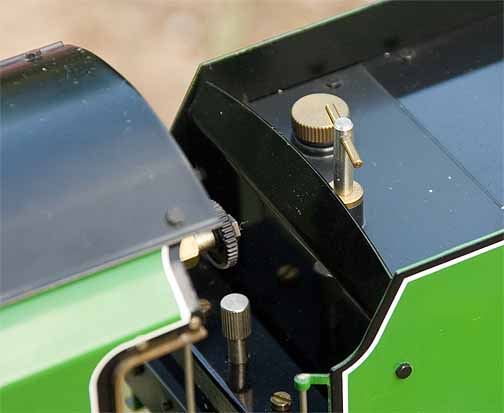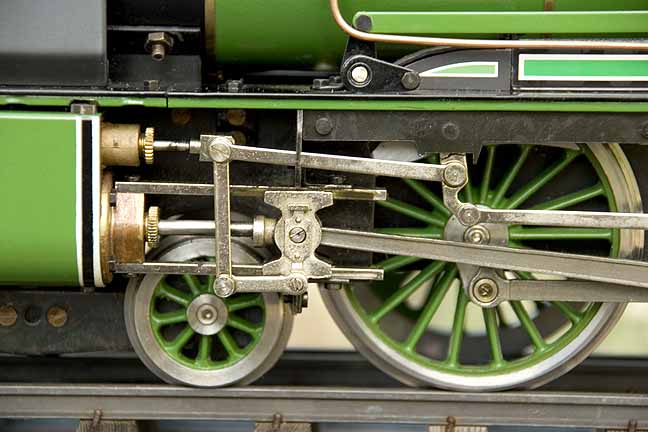
Back to Loco of the Month homepage
Back to Sidestreet Bannerworks
.
June 2007
Aster's "King Arthur"
by Marc Horovitz

The “King Arthur” class of locomotives (also known as the N15 class), began life as 4-6-0 engines, designed by R.W. Urie, for the London South Western Railway (LSWR). This was ultimately a large class of popular and successful locomotives, all named after figures from the Arthurian legend. There were ultimately over 70 engines built between the years of 1918 and 1927, some of which lasted into the 1960s. They appeared in a number of liveries over the years, including olive green, black, and, finally, in the Southern Railway's malachite green. One of the class, Sir Lamiel, is preserved at York.
After grouping in 1923, these engines became part of the Southern Railway system, under the direction of Richard Maunsell. Sir Balin, Nº 768, which Aster's model portrays, was built in 1925 by the North British Locomotive company and incorporated improvements by Maunsell. It was one of 30 engines known as the "Scotch Arthurs." Interestingly, there was another engine of the same class called Sir Balan (Nº 769). In the Arthurian legend, Sir Balin and Sir Balan were brothers. Sir Balin, which was originally used to haul the boat train from London Victoria to Dover, was withdrawn in 1961.
The engine
Aster's model captures well the character of the prototype. It came about as a way to utilize leftover parts from the “Schools" class engines the company issued three years earlier.
Mechanically, the "King Arthur" is a fairly basic engine and is similar to the "Schools" in many respects. Both have Smithies boilers and slip-return-crank reversing. They utilize the same drivers and cylinders. Neither has an onboard pump and they use an identical chicken-feed alcohol system. The "King Arthur" was fitted with a pressure gauge and water glass as standard, whereas the "Schools" was not. Both engines can take on water under pressure via a trackside pump. There is an inconvenient screw fitting under the right-hand side of the cab for this purpose. Valve gear is dummy Walschaerts, actually being simple eccentric.
One interesting feature that this six-coupled engine has is springing on its center driven axle. This spring is very light, so it helps keep all wheels on the rails, but doesn't provide much in the way of traction. Because this axle is sprung, the side rods are articulated.
The run
The model being reviewed today was built by a fellow who could never get it to run properly. I've had it for many years, but had never given it a go. Before steaming it, I gave it a good lubing, then put it up on blocks for an air test. It ran well and fast in both directions, although I could detect a little lumpiness.
After fueling and watering, I set it on the track, popped a fan in the stack, and opened the fuel valve. I then lit the fire, checking it with a dental mirror. All seemed OK. However, even though the engine got hot, after five minutes the needle had not lifted from its peg. Something was amiss, and I suspected the wicks. I checked again with the mirror and, sure enough, even though they were lit, all I could see were what appeared to be glowing embers.
I put out the fire and allowed the engine to cool a little, before removing the burner. I found that the asbestos-string wicks were packed solid! I don't know how the builder could have packed them as tightly as he did. I removed enough strands from each wick to loosen them up a reasonable amount. I had enough left over to fully pack another wick. Before replacing the burner, I lit the wicks on the bench just to see what the fire looked like. This time, all looked well.
I replaced the burner in the engine and the engine on the track. I put the fan back in the stack and relit the fire. This time, steam was up to 20 pounds inside of two minutes, so I turned on the blower. Working pressure was achieved in another minute or so and I opened the throttle and gave the engine a little push. I was treated to a geyser from the stack until the water level dropped a bit and the cylinders heated up, then the engine moved smoothly away.
I let it run a lap before tying on a half dozen of Aster's shorty Southern coaches, which made a splendid train. The exhaust note immediately became very loud indeed and I at once realized that I was hearing only three beats. These three were loud beats of seeming equal strength in regular rhythm. The engine handled the six coaches well enough on three-quarters power, but would obviously have been more comfortable if both cylinders had been working properly.
Water was soon exhausted, so I had to drop the fire, as I didn't have a trackside pump handy. I've never liked them, as they are slow and awkward. The engine would clearly benefit from a tender pump. There's plenty of room for one, so that may be a project for a rainy day.
But what about the missing exhaust beat? I've not had a chance to get into it but, since the three remaining beats were strong and regular, I suspect that the builder, instead of using the cylinder-head gaskets provided in the kit, used a gasket compound instead and accidentally applied too much on one area, which blocked one of the ports. Maybe I'll check it out when I install a water pump.
|
|
|
| Builder | Aster (Japan) |
| Date built | 1979 |
| Gauge | 1 {45mm) |
| Scale | 1:32 |
| Boiler | Smithies |
| Fittings | Safety valves (2), throttle, pressure gauge, blower, water glass, check valve |
| Fuel | Alcohol |
| Blow-off pressure | 45 psi |
| Cylinders | Two, double-acting D-valve |
| Reversing gear | Slip return crank |
| Lubricator | Displacement |
| Weight | 9 pounds, 0 ounces (with tender) |
| Dimensions | Length with tender, over buffers, 23-7/8"; width, 3-1/4"; height, 5-1/8" |





Above: Meths is carried in a small tank in the tender, controlled by a standard chicken-feed system. Visible are the filler plug and the control valve.
Left: Two safety valves perch atop the boiler, ahead of the cab. Behind them is a dummy whistle. The paint finish on the engine is to Aster's usual beautiful standard.

Below: The dummy Walschaerts valve gear. Note that the combination lever has only two pivot points, instead of three, making it and the anchor link merely ornamental.




Back to Loco of the Month home page
Back to Sidestreet Bannerworks home page
This page and its contents
Copyright Sidestreet Bannerworks, 2007
.